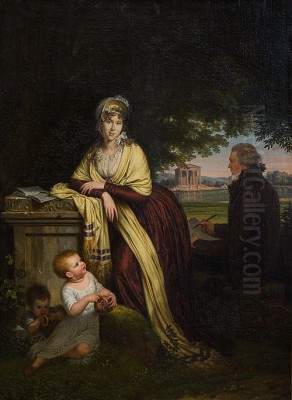
Louis Gauffier (1761-1801) stands as a significant, if sometimes overlooked, figure in the landscape of late 18th-century European art. A French painter who spent a crucial part of his career in Italy, Gauffier's work embodies the prevailing Neoclassical ideals of his time, yet also reflects a personal artistic journey that saw him navigate the demands of historical painting, the allure of portraiture, and the burgeoning appreciation for landscape. His relatively short life coincided with a period of immense political and social upheaval, particularly the French Revolution, which profoundly impacted his career trajectory and personal circumstances.
Born in La Rochelle, France, in 1761, Gauffier's early artistic inclinations led him to Poitiers and subsequently to Paris, the epicenter of French artistic training. His formal education took place at the prestigious Académie Royale de Peinture et de Sculpture, a bastion of classical art education. It was here that he honed his skills under the tutelage of artists who instilled in him the principles of line, form, and composition that were the hallmarks of the academic tradition.
Early Promise and Academic Triumph
The Académie Royale was the gateway to artistic recognition in France, and its most coveted prize was the Prix de Rome. This scholarship enabled promising young artists to travel to Rome and study firsthand the masterpieces of antiquity and the Renaissance, an experience considered essential for any aspiring history painter. Gauffier's talent was undeniable, and in 1784, he achieved this pinnacle of student ambition.
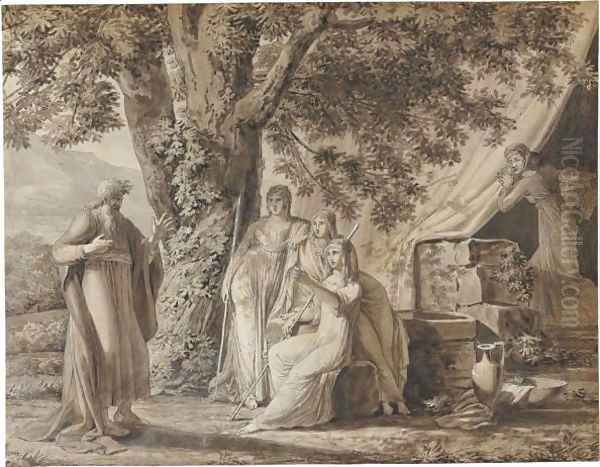
His winning entry for the Prix de Rome was the painting Christ and the Woman of Canaan (sometimes referred to by the title of an earlier, similar subject, The Canaanite Woman at the Feet of Christ). This work demonstrated his mastery of the Neoclassical style, characterized by its clarity of narrative, balanced composition, idealized figures, and restrained emotion. The subject matter, drawn from the New Testament, was typical of the moral and didactic themes favored by the Academy. Winning this prize placed Gauffier in the esteemed company of artists like Jacques-Louis David, who had won it over a decade earlier and was by then establishing himself as the leading figure of French Neoclassicism. Among Gauffier's contemporaries and competitors for the prize was Jean-Germain Drouais, another highly talented pupil of David, highlighting the competitive environment of the Parisian art scene.
The Roman Sojourn: History Painting and Italian Influences
The Prix de Rome secured Gauffier a place at the French Academy in Rome, housed in the Palazzo Mancini. Arriving in Italy, he immersed himself in the study of classical sculpture, Roman architecture, and the works of Renaissance masters such as Raphael and Michelangelo. This period was crucial for his development as a history painter, the most esteemed genre within the academic hierarchy.
During his initial years in Rome, Gauffier produced several significant historical and biblical compositions. Works such as The Roman Matrons Offering their Jewels to the Senate and The Angels Appearing to Abraham exemplify his adherence to Neoclassical principles. These paintings are marked by their carefully constructed compositions, statuesque figures often inspired by classical reliefs, and a palette that, while rich, maintained a sense of order and harmony. He demonstrated a keen ability to render textures, particularly drapery, with a refined elegance.
However, Rome offered more than just ancient ruins and Renaissance frescoes. The Italian landscape itself, with its picturesque vistas and luminous light, began to captivate Gauffier. He, like many artists before him such as Claude Lorrain and Nicolas Poussin, and contemporaries like Pierre-Henri de Valenciennes, started to explore the countryside, making sketches and developing an appreciation for landscape as a subject in its own right. This growing interest would become more prominent later in his career.
A Shift in Florence: Portraiture and Landscape in a Changing World
The outbreak of the French Revolution in 1789, and the subsequent political turmoil, had a profound impact on French artists living abroad, particularly in Rome, where anti-French sentiment grew. The execution of Louis XVI in 1793 made the situation for French expatriates precarious. Gauffier, reportedly due to his aversion to the political climate in France and the instability in Rome, chose to relocate to Florence around this time.

Florence, with its rich artistic heritage and a significant community of international residents and travelers on the Grand Tour, offered new opportunities. While he had been trained as a history painter, the demand for large-scale historical canvases from French patrons dwindled due to the Revolution. In Florence, Gauffier increasingly turned to portraiture to support himself. He became a sought-after painter for the local aristocracy and the many foreign visitors, particularly British and other European nobles and intellectuals.
His portraits from this period, such as the Portrait of Dr. Thomas Penrose (1798) and The Family of André-François, Count Miot de Melito (1795-1796), showcase his skill in capturing a likeness while imbuing his sitters with an air of Neoclassical elegance. These portraits often feature carefully rendered details of costume and setting, sometimes incorporating classical motifs or picturesque landscape backgrounds, subtly blending his different artistic interests. The Portrait of Gustaf Mauritz Armfelt, a Swedish diplomat, is another notable example, hinting at the sitter's character and status through pose and attribute.
Alongside portraiture, Gauffier's interest in landscape painting flourished in Tuscany. The serene beauty of the Arno valley and the surrounding hills provided ample inspiration. He produced a number of exquisite landscapes, such as Le couvent de Vallombrosa et le Val d'Arno vu du Paradisino (1796) and La Vue de l'Abbaye de Vallombrosa (1797). These works are characterized by their delicate rendering of light and atmosphere, precise depiction of architectural elements within the natural setting, and an overall sense of tranquility. They reflect the growing contemporary taste for landscape painting that was moving beyond the purely idealized or heroic towards a more direct, albeit still composed, observation of nature. His approach to landscape shows an affinity with the developing theories of artists like Valenciennes, who advocated for outdoor sketching to capture natural effects.
Artistic Style and Defining Characteristics
Louis Gauffier's art is firmly rooted in the Neoclassical tradition, yet it possesses a distinctive refinement and often a lyrical quality that sets it apart from the more austere and heroic style of artists like Jacques-Louis David. His early training under Hugues Taraval, an artist whose style bridged Rococo grace with emerging Neoclassical clarity, may have contributed to this nuanced approach.
Composition and Line: Gauffier's compositions are typically balanced and harmonious, often drawing on classical friezes for inspiration in his history paintings. His drawing is precise and elegant, defining forms with clarity and grace. Even in his portraits and landscapes, there is an underlying sense of order and careful arrangement.
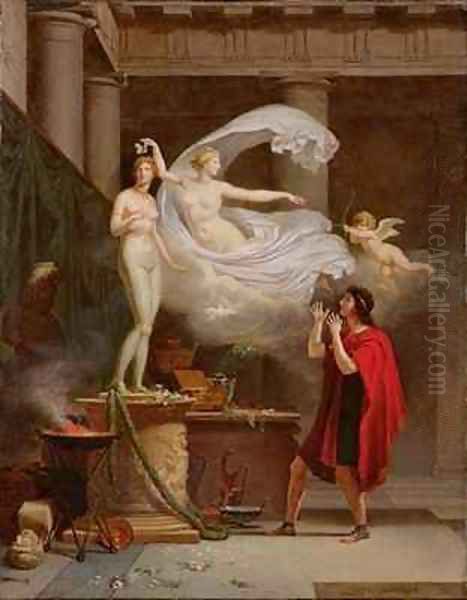
Light and Color: He demonstrated a sophisticated understanding of light, using it to model forms, create atmosphere, and unify his compositions. His light is often clear and luminous, particularly in his Italian landscapes, capturing the distinctive quality of Mediterranean illumination. His palette is generally refined, employing rich but controlled colors that contribute to the overall elegance of his work. He avoided the dramatic chiaroscuro of the Baroque, favoring a more even and subtle distribution of light and shadow.
Subject Matter and Interpretation: While adept at history painting, as seen in works like Jacob with the daughters of Laban (1787) or Achilles Recognized by Ulysses at Lycomedes' Court, Gauffier often brought a gentle, almost intimate quality to his mythological and biblical scenes. His Pygmalion and Galatea (1797), for instance, focuses on the moment of divine animation with a sense of wonder and idealized beauty, omitting the more tormented aspects of Ovid's narrative. This tendency towards a softer, more poetic interpretation distinguishes him from the more overtly political or didactic Neoclassicism of some of his contemporaries.
His portraits, while adhering to conventions of likeness and status, often convey a sense of quiet dignity. He was skilled at rendering the textures of fabrics and the details of contemporary fashion, which added to the appeal for his clientele. In his landscapes, he combined topographical accuracy with an idealized vision of nature, creating scenes that were both recognizable and aesthetically pleasing. Le Repos en Égypte (The Rest on the Flight into Egypt) is another example where a biblical narrative is set within a carefully composed landscape, blending his skills in figure and nature painting.
Contemporaries and Artistic Milieu
Gauffier's career unfolded within a vibrant and competitive artistic world. In Paris, he was a contemporary of David's pupils, including Jean-Germain Drouais, Anne-Louis Girodet-Trioson, and François Gérard. While David's influence was pervasive, artists like Gauffier developed their own interpretations of Neoclassicism.
In Italy, he was part of a large international community of artists. Besides French colleagues like François-Xavier Fabre, who also settled in Florence and became a notable collector and painter, Gauffier would have been aware of the work of leading Italian Neoclassical artists such as the sculptor Antonio Canova, whose studio in Rome was a major attraction. He may also have encountered painters like Andrea Appiani or Gaspare Landi. The legacy of earlier Roman portraitists catering to Grand Tourists, such as Pompeo Batoni, also formed part of the artistic backdrop.
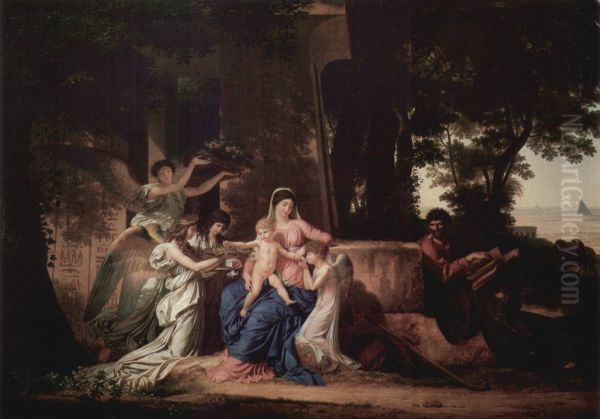
The influence of landscape theorists and practitioners like Pierre-Henri de Valenciennes was significant for Gauffier's development in that genre. Valenciennes' emphasis on direct observation and the study of light effects resonated with many artists of the period. Gauffier's landscapes can be seen as part of this broader movement that paved the way for 19th-century landscape painting. He also worked within a tradition of French artists in Italy, looking back to the classical landscapes of Poussin and Claude Lorrain, but infusing them with a more contemporary sensibility. Other artists like Hubert Robert, known for his picturesque views and capriccios often featuring Roman ruins, also contributed to the visual culture Gauffier inhabited.
His wife, Pauline Châtillon, whom he married in Rome, was also a painter, specializing in mythological subjects and portraits. Her presence suggests a shared artistic life, though her career is less documented than her husband's. The artistic circles in Rome and Florence were relatively close-knit, and interactions, collaborations, and rivalries were common.
Personal Life and Untimely Demise
Louis Gauffier's personal life, particularly in his later years, was marked by tragedy. He married Pauline Châtillon, and they had at least two children. The family established themselves in Florence, where Gauffier found a measure of success as a portraitist and landscape painter. However, his health was reportedly fragile.
In a devastating blow, his wife Pauline died in early 1801. Gauffier himself, already suffering from ill health, succumbed just a few months later in Florence, at the young age of 39 or 40. This premature end cut short a career that was still evolving and adapting to the changing artistic and social landscape of Europe. His death left his children orphaned and brought an abrupt close to his artistic production.
Legacy and Significance
Louis Gauffier's legacy is that of a highly skilled and refined Neoclassical painter who successfully navigated the transition from the pre-revolutionary art world focused on grand history painting to the more diverse demands of the late 18th and early 19th centuries. While he may not have achieved the revolutionary impact of Jacques-Louis David or the enduring fame of Jean-Auguste-Dominique Ingres (who came slightly later), Gauffier's work holds an important place in the history of French and European art of the period.
His history paintings demonstrate a mastery of academic principles combined with a personal sensibility that favored elegance and harmony. His portraits provide valuable records of the personalities of his era, rendered with a characteristic Neoclassical grace. Perhaps most significantly, his landscapes, particularly those of the Tuscan countryside, contribute to the development of landscape painting as an independent genre, showcasing a keen observation of nature and a delicate handling of light and atmosphere.
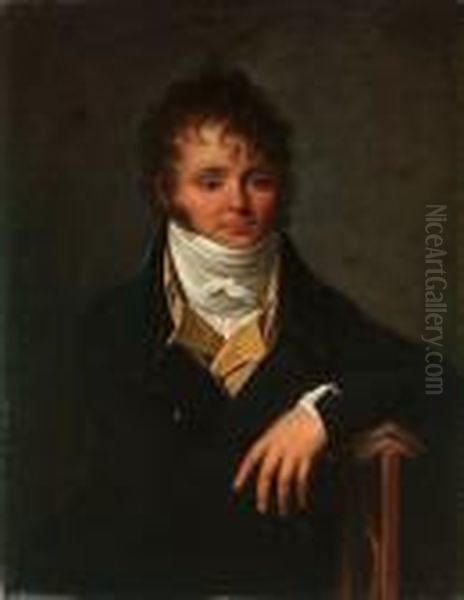
Gauffier's career reflects the broader shifts in artistic patronage and taste that occurred during the revolutionary period. The decline in demand for large-scale history paintings led many artists, including Gauffier, to explore other genres like portraiture and landscape, which found favor with a new class of patrons and collectors. His work, preserved in museums such as the Musée Fabre in Montpellier, the Manchester Art Gallery, and the Minneapolis Institute of Art, continues to be appreciated for its technical skill, aesthetic appeal, and its embodiment of the refined spirit of late 18th-century Neoclassicism. He remains a testament to an artist who, despite a short life and challenging times, produced a body of work characterized by its consistent quality and enduring charm.